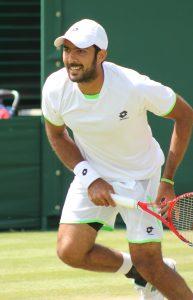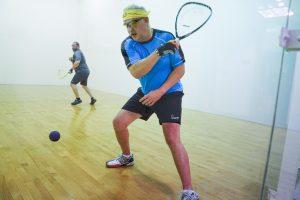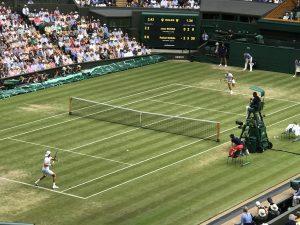We may earn money or products from the companies mentioned in this post.
Introduction

Tennis is a sport that has captured the hearts of millions around the world With its origins dating back to the 12th century, tennis has evolved into a popular and competitive game enjoyed by players of all ages and skill levels From its humble beginnings as a leisure activity for French monks to becoming a global phenomenon, tennis has come a long way
Brief history of tennis
The roots of tennis can be traced back to medieval times when it was played in various forms across Europe The modern game we know today originated in England during the late 19th century It quickly gained popularity among aristocrats and later spread to different parts of the world Tennis became an Olympic sport in 1896 and continues to be one of the most-watched sports events globally
Importance and benefits of playing tennis
1 Physical benefits
Playing tennis offers numerous physical benefits that contribute to overall health and well-being It is a highly aerobic sport that improves cardiovascular fitness, agility, speed, and coordination The constant movement required on the court helps build endurance and muscular strength, especially in the lower body muscles such as legs and core
Tennis also enhances flexibility due to the various movements involved, such as reaching for shots or performing quick changes in direction It improves hand-eye coordination through precise racket control and ball placement Additionally, regular participation in tennis can help maintain a healthy weight, reduce the risk of chronic diseases such as heart disease or diabetes, and promote bone density
2 Mental benefits
Beyond its physical advantages, playing tennis provides significant mental benefits as well The fast-paced nature of the game requires quick thinking, strategizing, problem-solving skills, and decision-making under pressure It improves cognitive function, sharpening focus, concentration, and mental agility
Tennis is also known to relieve stress and improve mood Engaging in physical activity releases endorphins, which are natural mood boosters The social aspect of playing tennis adds to the mental well-being as it provides opportunities for social interaction, boosting self-confidence and reducing feelings of loneliness or isolation
3 Social benefits
Tennis is a sport that can be played individually or in pairs, making it an excellent avenue for socializing and building relationships Whether it’s joining a local club, participating in tournaments, or simply hitting the court with friends, tennis fosters a sense of community and camaraderie
Playing tennis promotes teamwork and sportsmanship since it requires fair play and respect towards opponents It offers opportunities to meet new people from diverse backgrounds who share a common passion for the sport This social aspect not only enriches one’s personal life but also provides networking opportunities both on and off the court
Mastering the Basics

When it comes to tennis, mastering the basics is crucial for any player looking to improve their game Understanding the rules and scoring system is where it all begins
Singles vs Doubles Matches
Tennis can be played in either singles or doubles matches In singles, it’s a one-on-one showdown between two players, while doubles involves teams of two players on each side of the court Each format has its own unique strategies and dynamics
Service Rules and Rotation
The service rules are an important aspect of tennis The server must stand behind the baseline and hit the ball into the opponent’s service box diagonally across from them After each point, the server alternates sides until the game is over
Point System and Tiebreakers
In tennis, points are scored as 15, 30, 40, with “love” representing zero To win a game, a player must win four points with at least a two-point advantage over their opponent If both players reach 40-40 (also known as deuce), they enter a tiebreaker to decide who wins that particular game
Essential Equipment

Choosing the Right Tennis Racket
Selecting the right tennis racket can greatly impact your performance on the court When choosing a racket, consider factors such as materials used in construction (graphite or aluminum), weight distribution (head-heavy or head-light), and grip size (small or large) to find one that suits your playing style
Clothing, Shoes, and Accessories
Proper attire is essential for comfort and mobility during a tennis match Opt for lightweight clothing that allows for unrestricted movement Additionally, invest in a good pair of tennis shoes with ample cushioning and support to prevent injuries Don’t forget accessories like wristbands and hats to protect yourself from the sun
Balls: Types, Materials, and Pressure
Tennis balls come in various types and materials, each offering different playing characteristics Opt for pressurized balls for competitive matches or non-pressurized balls for practice sessions Different surfaces may also require specific ball types Make sure to check the recommended pressure indicated on the ball’s packaging
Tennis Court Layout and Dimensions

The tennis court layout consists of several key components: the baseline, service line, net, singles sidelines, doubles sidelines, and center service mark The dimensions of a standard tennis court are 78 feet long and 27 feet wide for singles matches, while doubles matches require a wider court measuring 36 feet wide
Techniques for Improvement

Groundstrokes
When it comes to improving your groundstrokes, there are a few key techniques to focus on Firstly, let’s talk about the forehand technique Your grip style can greatly impact your shot, with options such as Eastern, Semi-Western, and Western grips offering different advantages Mastering proper footwork patterns is also essential for getting into the right position to hit powerful and consistent forehands And don’t forget about the follow-through! A clean follow-through will help you maintain control and generate power in your shots
Next up is the backhand technique Here, you have a choice between a one-handed or two-handed grip Experiment with Eastern or Semi-Western grips to find what works best for you Just like with the forehand, mastering footwork patterns specific to the backhand will help you get into optimal positions to execute strong shots And remember, a solid follow-through is crucial for consistency and power in your backhand strokes
Serving Techniques
Your serve can be a game-changer, so it’s important to develop effective techniques here as well Start by understanding the different types of serves at your disposal: flat serves, slice serves, and kick or topspin serves Each serve offers unique benefits and can be used strategically during matches
In addition to mastering different serve types, placement strategies are key Understanding where to target within the service box can give you an edge over your opponent By aiming for specific areas in relation to their positioning or weaknesses, you can put pressure on them right from the start of each point
Returns
The ability to return your opponent’s shots effectively requires quick reflexes and anticipation skills Practicing drills that simulate different types of shots and varying speeds can help improve your reaction time By training your eyes to read the ball’s trajectory and understanding your opponent’s tendencies, you can anticipate their shots better and respond with more control
Volleys at the Net
When playing at the net, being comfortable with both forehand and backhand volleys is crucial These shots require a different technique than groundstrokes, as they involve shorter swings and quicker reactions Practice drills that focus on volleying from various positions on the court to develop your skills in this area And don’t forget about overhead smashes for those high balls that come your way!
Lobs
Lobs can be used both offensively and defensively to gain an advantage in a match Offensive lobs are aimed at catching your opponent off guard by hitting the ball high over their head, forcing them to retreat quickly Defensive lobs, on the other hand, are used when you’re out of position or under pressure, giving yourself some breathing room by sending the ball deep into their court
By focusing on these techniques for improvement, you can take your tennis game to new heights Practice regularly, analyze your strengths and weaknesses, and implement these strategies into your training sessions to see significant progress on the courtWhen it comes to advanced tactics and strategies in tennis, there are several key areas to focus on In singles matches, understanding your opponent’s strengths and weaknesses is crucial By identifying their weaknesses, you can strategically attack those areas, putting them on the defensive and gaining an advantage Additionally, mixing up your shot selection keeps opponents guessing, making it harder for them to anticipate your next move
In doubles matches, team chemistry and communication are essential Working well together with your partner can lead to a more cohesive and effective strategy Serve and volley tactics are also commonly employed in doubles, allowing for aggressive play at the net and putting pressure on the opposing team Another strategy known as poaching involves one player aggressively moving towards the net when their partner serves or hits a powerful shot from the baseline
Physical conditioning plays a vital role in tennis performance Strength and endurance exercises help players maintain power throughout long matches, while speed and agility drills improve footwork and reaction time on the court Flexibility training is also important for injury prevention, as it helps players move more fluidly without straining muscles or joints
Mental preparation is just as crucial as physical conditioning in tennis Setting goals for improvement gives players something to strive towards, helping them stay motivated and focused during training sessions and matches Handling pressure situations is another aspect of mental preparation that can make a significant difference in performance Learning how to stay composed under pressure allows players to make better decisions and execute shots more effectively Finally, overcoming mental obstacles such as fear, frustration, or anger is key to maintaining a positive mindset during matches
By incorporating these advanced tactics into your game plan, you’ll be well-equipped to take your tennis skills to new heights Whether you’re playing singles or doubles, focusing on player strengths and weaknesses, using strategic shot selection, improving physical conditioning, honing mental preparation techniques – all these elements contribute to becoming a well-rounded player capable of handling any challenge on the court
Conclusion

In conclusion, improving your tennis skills requires dedication, commitment, and a growth mindset By implementing the strategies and techniques discussed in this article, you can take your game to the next level Remember, practice is essential for honing your skills and developing muscle memory Patience is key as progress may not always be linear or immediate Embracing a growth mindset will allow you to view challenges as opportunities for learning and improvement
Continuing Improvement
To continue improving your tennis skills, it’s important to maintain a consistent practice routine Set aside regular time each week to work on various aspects of your game – from serving and volleys to footwork and strategy Consider seeking guidance from a professional coach who can provide personalized feedback and help you identify areas for improvement
Additionally, playing matches against opponents of different skill levels can enhance your tactical awareness and challenge you to adapt your gameplay Participating in local tournaments or joining a tennis club can provide opportunities for friendly competition and further skill development
The Importance of Practice
Practice is the foundation of skill development in any sport, including tennis Consistent practice allows you to refine technique, build strength and endurance, improve coordination, and develop strategic thinking on the court
When practicing, focus on quality over quantity Instead of mindlessly hitting balls back and forth without purpose, set specific goals for each session Break down complex movements into smaller components and work on them individually before integrating them into full strokes or sequences
Patiently Progressing
Improving your tennis skills takes time – it’s not an overnight process It’s important to have patience with yourself as you navigate the ups and downs of skill development Understand that progress may be gradual at times but trust in the process and remain committed to your goals
Instead of getting discouraged by setbacks or slow progress, view them as opportunities for learning and growth Analyze your performance objectively, identify areas that need improvement, and adjust your practice routine accordingly Stay motivated by celebrating small victories along the way and reminding yourself of the long-term benefits of perseverance
Fostering a Growth Mindset
A growth mindset is essential for continuous improvement in any endeavor, including tennis Embrace challenges as opportunities to learn and develop new skills Rather than shying away from difficult opponents or situations, approach them with a positive attitude and a willingness to push beyond your comfort zone
Avoid comparing yourself to others and instead focus on your own progress Recognize that setbacks are part of the learning process and use them as motivation to keep striving for improvement Cultivate self-belief and maintain a resilient mindset even in the face of adversity
In summary, improving your tennis skills requires a combination of practice, patience, and a growth mindset By dedicating time to regular practice sessions, remaining patient through the ups and downs of skill development, and fostering a growth mindset that embraces challenges, you can continue progressing on your tennis journey Remember, every step forward is a step towards becoming a better player
Useful Links

How To Get Better At Tennis
Tips From a Tennis Pro: Why Regular Play Is Essential to …
Powerful tennis tips for BEGINNERS
How To Beat A Better Player
The Real World: Why playing better players is bad for your …
How to become a better tennis competitor in 4 steps
Tennis Improvement: The Real Keys To Getting Better At …
Top 20 Actionable Tennis Tips For Beginners| (That Make …
10 Things You Need to Know about Great Tennis Coaches
Advice for parents of a child that plays tennis
How to Play Tennis | A Beginners Guide to the Sport
Footwork | Playing Tennis Outdoors | Humidity | Sun
Tennis Doubles Strategy: A Complete Guide
Is Tennis Good Exercise? All You Need to Know
Tennis Singles Strategy: 8 Tactics to Help You Win!
Is Nick Kyrgios good for tennis?
What Sets the Tennis Elite Apart from the Rest?






